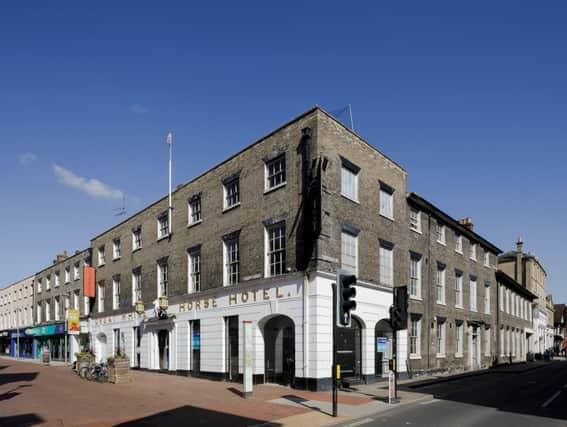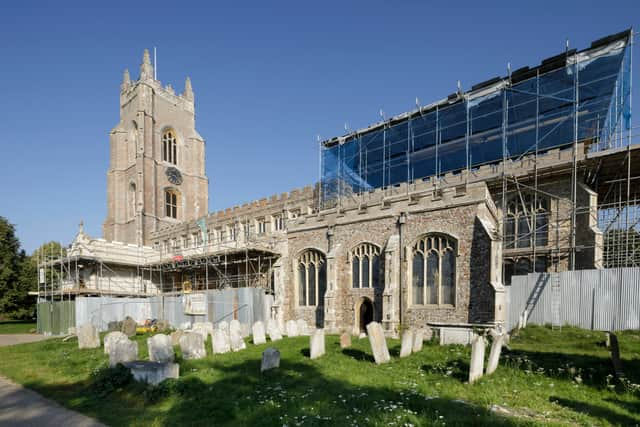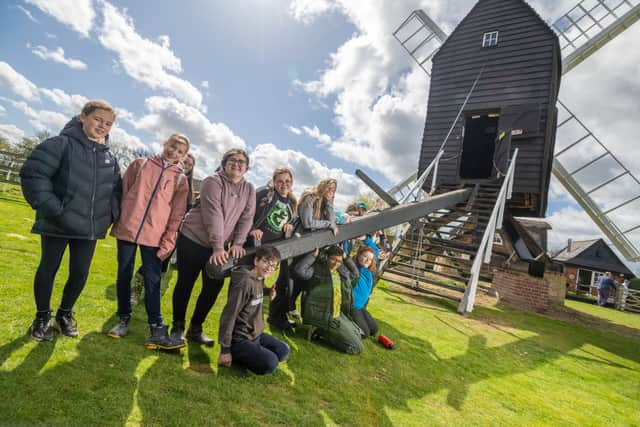Suffolk hotel where the Beatles and King George II stayed among buildings 'at risk' in the East of England


A UK hotel which served as inspiration the Charles Dickens and played host to King George II has been named as a historic site at risk in the UK. The Ipswich hotel is among 159 buildings added to Historic England's Heritage at Risk Register and also counts music royalty such as the Beatles among its former guests.
A total of 203 sites have also been rescued and therefore removed from the annually updated list. This year marks 25 years since the list was first published.
Advertisement
Hide AdAdvertisement
Hide AdOriginally a timber-frame building back in the 16th and 17th centuries, the Great White Horse Hotel in Ipswich was refronted, using Suffolk white bricks, in the early 19th century. The elegant entrance features white pillars, gold lettering and the figure of a white horse above the doorway.
In 1893, a replica of the hotel represented Great Britain at the World’s Fair in Chicago. A regular guest was Charles Dickens, who drew inspiration from it for the inn in his first novel, 'The Pickwick Papers', published in 1836.


Historic England has said the building is at risk because there is active dry rot in the second floor ‘Dickens room’, loose plaster detailing in the ballroom, and deteriorating windows and exterior joinery. Works to fix these issues are being discussed by Historic England with local authorities The hotel in the East of England isn't the only landmark in the region to be added to this year's list though. Another addition is the Church of St Mary in Stoke-by-Nayland, Suffolk.
A church has stood on this site for at least a thousand years and it was rebuilt in perpendicular style in the 15th century under the patronage of Sir John Howard, who was instated as Duke of Norfolk in 1483. The church tower dominates the surrounding Dedham Vale landscape and was a frequent focus of paintings by John Constable, who described the "the lofty and slender proportions of the tower arch are the crowning beauty of the whole interior".
Advertisement
Hide AdAdvertisement
Hide AdIn 2020, some of the south wall aisles fell revealing further crucial structural instability. Planned work to re-slate the chancel roof also uncovered the unstable condition of parts of its walls which have had to be replaced. A fundraising campaign and a £135,507 Historic England grant should see most repair works completed by the end of the year.
Duncan Wilson, chief executive of Historic England said: “Protecting our heritage is so important. It is truly inspirational to see communities coming together to help save historic buildings and places and find new uses for them.


"The Heritage at Risk programme shines a light on our historic sites most in need and can help to attract funding and help. After a quarter of a century of the Heritage at Risk Register, we are celebrating how many places have been saved and continue to find new ways to involve local people in caring for and enjoying their heritage.”
One building removed from the Heritage at Risk register in the East of England is Bourn Mill in Cambridgeshire - one of the oldest windmills in England that was saved from collapse.
Advertisement
Hide AdAdvertisement
Hide AdThe main post, the oldest part of Bourn Mill, was made from a tree felled between 1513 and 1549, making this the earliest windmill yet dated. The mill, which provided creative inspiration for eminent architect Lord Norman Foster, was added to the Heritage at Risk Register in 2021 as it was at risk of collapse.
Working in partnership with volunteers and local people, Cambridgeshire Past Present and Future, The National Lottery Heritage Fund, Historic England and the Society for the Protection of Ancient Buildings enabled the urgent repair and conservation work needed to save this special local landmark.
Arts and Heritage Minister Lord Parkinson of Whitley Bay added: "For a quarter of a century, the Heritage at Risk Register has helped to focus efforts to preserve cherished sites across the country. It is heartening to see that so many sites have had their futures secured and have been taken off the Register over the past year thanks to the hard work of Historic England and local people.
"I look forward to the new additions to the Register receiving similar care and attention so that future generations can continue to enjoy and learn from our rich heritage for years to come."
Historic England said there are 48 fewer total entries on the list compared with 2022, and around 6,800 entries have been removed since the list began in 1998.
Comment Guidelines
National World encourages reader discussion on our stories. User feedback, insights and back-and-forth exchanges add a rich layer of context to reporting. Please review our Community Guidelines before commenting.
